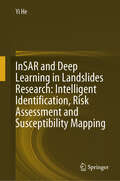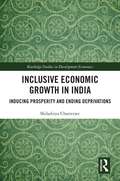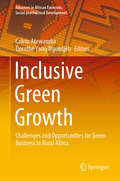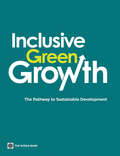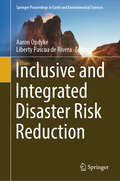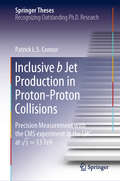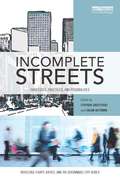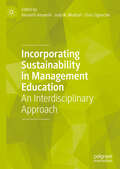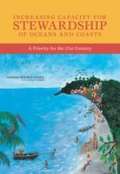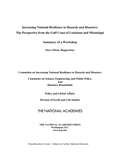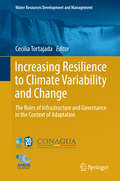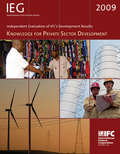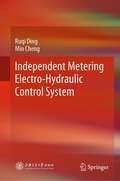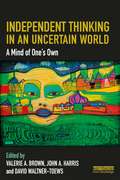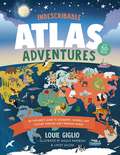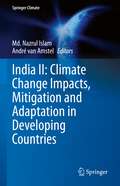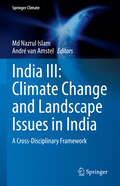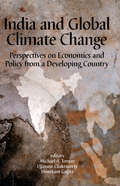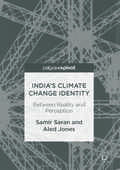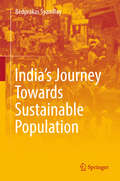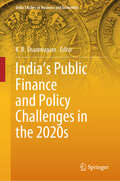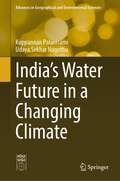- Table View
- List View
InSAR and Deep Learning in Landslides Research: Intelligent Identification, Risk Assessment and Susceptibility Mapping
by Yi HeThis book combines remote sensing and deep learning technology to develop a variety of models in the study of different type landslides in a wide range of areas including northwest, southwest and southern China. It explores the application of various deep learning methods in landslide identification and sensitivity mapping. It also explores intelligent landslide monitoring and susceptibility mapping using a variety of data and methods, providing ideas and methods for landslide prevention and mitigation. This book is suitable for professionals in the field of landslide monitoring and graduate students in the fields of remote sensing and geological hazards research to mitigate this most widespread and harmful geological hazards in the world.
Inclusive Economic Growth in India: Inducing Prosperity and Ending Deprivations (Routledge Studies in Development Economics)
by Shiladitya ChatterjeeChatterjee discusses India’s economic strengths and weaknesses and its progress towards inclusive growth by providing an overview of the Indian economy, its future challenges and current policy strategies.Chatterjee’s overview of the economy touches on its historical, geographical and socio-political context. Considering the factors that contribute to its current growth such as India’s low dependency ratio, vast internal market and growing private sector and entrepreneurial class, he argues that inclusive growth rests amongst others on agricultural transformation and targeted policies that address the needs of medium, small and microenterprises (MSMEs) which dominate industry and constitute the majority of the informal and services economy; and also interventions directed at social groups and geographical regions falling behind. Benchmarking India’s progress on achieving the Sustainable Development Goals (SDGs), this book closes by advancing policy options to address various inequities and deprivations including social inequalities, in particular the issues of ethnic division, gender and caste, going beyond the blunt instrument of affirmative action.Having served at the state and central levels of Indian government and the Asian Development Bank, Chatterjee presents the pressing issues of inclusive growth in India in an accessible volume, one of interest to development economists, researchers in development studies and inclusive growth as well as policy makers.
Inclusive Finance: How Fintech and Innovation Can Transform Financial Inclusion
by Alessandro Hatami Meaghan JohnsonReduce financial exclusion, improve social impact, meet regulatory compliance and tap into market opportunities with Inclusive Finance. Financial institutions are under growing pressure from their customers, regulators and employees to play more active roles in supporting underbanked and unbanked individuals. Inclusive Finance reviews what is currently socially broken in the existing financial system and identifies opportunities for how incumbent players, fintech start-ups and scale ups can improve their social impact and meet compliance requirements while delivering financial profit. Inclusive Finance explores how innovations such as blockchain, distributed ledger technology, AI, cryptocurrencies and stablecoins, tokenization and DeFi can all play a role in democratizing finance. Written by two esteemed finance experts that are driving digital innovation,this is an indispensable guide for finance professionals and organizations who need to address financial exclusion, making the global economy larger and fairer.
Inclusive Green Growth: Challenges and Opportunities for Green Business in Rural Africa (Advances in African Economic, Social and Political Development)
by Calvin Atewamba Dorothé Yong NgondjebFostering inclusive green growth in Africa means addressing existing and emerging development challenges, while efficiently managing Africa’s natural capital and building resilience to environmental, social and economic risks. Although this new paradigm for development has the potential to create tremendous business opportunities, there are also challenges. This book provides empirical evidence on the conditions for the emergence of green businesses in Africa. It includes 13 case studies, which identify the determinants of small and medium-size enterprises’ engagement in inclusive and sustainable growth in rural Africa, and the factors that hinder eco-innovation in business and entrepreneurial activities. Furthermore it discusses appropriate regulations and policies to stimulate the development of green business in Africa. Offering insights into the relationship between eco-innovation, labor productivity and business competitiveness in rural Africa, this book appeals to scholars, policy makers and practitioners interested in a green economy for Africa.
Inclusive Green Growth: The Pathway to Sustainable Development
by Marianne FayAs the global population heads toward 9 billion by 2050, decisions made today will lock countries into growth patterns that may or may not be sustainable in the future. Care must be taken to ensure that cities and roads, factories and farms are designed, managed, and regulated as efficiently as possible to wisely use natural resources while supporting the robust growth developing countries still need. Economic development during the next two decades cannot mirror the previous two: poverty reduction remains urgent but growth and equity can be pursued without relying on policies and practices that foul the air, water, and land. Inclusive Green Growth: The Pathway to Sustainable Development makes the case that greening growth is necessary, efficient, and affordable. Yet spurring growth without ensuring equity will thwart efforts to reduce poverty and improve access to health, education, and infrastructure services. Countries must make strategic investments and farsighted policy changes that acknowledge natural resource constraints and enable the world's poorest and most vulnerable to benefit from efficient, clean, and resilient growth. Like other forms of capital, natural assets are limited and require accounting, investment, and maintenance in order to be properly harnessed and deployed. By maximizing co-benefits and avoiding lock-in, by promoting smarter decisions in industry and society, and by developing innovative financing tools for green investment, we can afford to do the things we must.
Inclusive Innovation for Sustainable Development
by Alan Hunter Nathaniel O. AgolaEmploying a three-dimensionalapproach, this book discusses inclusive innovation for socio-economic growthand development, and the implications for human security within the context ofdeveloping and emerging economies. Focusing on a new and innovative area ofresearch, Inclusive Innovation forSustainable Development explores new social and technological processesthat are created within, and for the benefit of, marginalised populations. Considering policy and issues surrounding technology, business strategies andbest practices, theoretical underpinnings and a broader contextualisation, theauthors interrogate the concept of the inclusivity of innovations. Written fromthe perspective of the new UN paradigm which states that "no one will be leftbehind", the book considers the potential contribution of modern technology tohuman security and develops frameworks that counter the potential increases in inequalitythat this may bring. With contributions from leading international scholars ina range of disciplines, as well as practitioners in international developmentorganizations and private sector actors InclusiveInnovation for Sustainable Development provides a way forward for excludedmajority populations to take control of innovative technologies and businessprocesses.
Inclusive and Integrated Disaster Risk Reduction (Springer Proceedings in Earth and Environmental Sciences)
by Aaron Opdyke Liberty Pascua de RiveraThis book provides an interdisciplinary volume of advances in disaster science that further understanding global progress to reduce disaster risk. As we pass the halfway point on implementing the Sendai Framework for Risk Reduction, the question stands what progress has been made on reducing disaster risk at the global and local scales? The book is thematically grouped around the Sendai Framework’s four priorities, spanning efforts to assess hazards and risk, disaster governance, mechanisms to build resilience, and recovery in the aftermath of crises. This book offers scholars and practitioners a glimpse into the opportunities and challenges at the forefront of disaster risk reduction efforts.
Inclusive b Jet Production in Proton-Proton Collisions: Precision Measurement with the CMS experiment at the LHC at √ s = 13 TeV (Springer Theses)
by Patrick L.S. Connor^ 74 GeV and |y|
Incomplete Streets: Processes, practices, and possibilities (Routledge Equity, Justice and the Sustainable City series)
by Julian Agyeman Stephen ZavestoskiThe ‘Complete Streets' concept and movement in urban planning and policy has been hailed by many as a revolution that aims to challenge the auto-normative paradigm by reversing the broader effects of an urban form shaped by the logic of keeping automobiles moving. By enabling safe access for all users, Complete Streets promise to make cities more walkable and livable and at the same time more sustainable. This book problematizes the Complete Streets concept by suggesting that streets should not be thought of as merely physical spaces, but as symbolic and social spaces. When important social and symbolic narratives are missing from the discourse and practice of Complete Streets, what actually results are incomplete streets. The volume questions whether the ways in which complete streets narratives, policies, plans and efforts are envisioned and implemented might be systematically reproducing many of the urban spatial and social inequalities and injustices that have characterized cities for the last century or more. From critiques of a "mobility bias" rooted in the neoliberal foundations of the Complete Streets concept, to concerns about resulting environmental gentrification, the chapters in Incomplete Streets variously call for planning processes that give voice to the historically marginalized and, more broadly, that approach streets as dynamic, fluid and public social places. This interdisciplinary book is aimed at students, researchers and professionals in the fields of urban geography, environmental studies, urban planning and policy, transportation planning, and urban sociology.
Inconspicuous Consumption: The Environmental Impact You Don't Know You Have
by Tatiana SchlossbergFrom a former New York Times science writer, this urgent call to action will empower you to stand up to climate change and environmental pollution by making simple but impactful everyday choices.With urgency and wit, Tatiana Schlossberg explains that far from being only a distant problem of the natural world created by the fossil fuel industry, climate change is all around us, all the time, lurking everywhere in our convenience-driven society, all without our realizing it. By examining the unseen and unconscious environmental impacts in four areas-the Internet and technology, food, fashion, and fuel - Schlossberg helps readers better understand why climate change is such a complicated issue, and how it connects all of us: How streaming a movie on Netflix in New York burns coal in Virginia; how eating a hamburger in California might contribute to pollution in the Gulf of Mexico; how buying an inexpensive cashmere sweater in Chicago expands the Mongolian desert; how destroying forests from North Carolina is necessary to generate electricity in England. Cataloging the complexities and frustrations of our carbon-intensive society with a dry sense of humor, Schlossberg makes the climate crisis and its solutions interesting and relevant to everyone who cares, even a little, about the planet. She empowers readers to think about their stuff and the environment in a new way, helping them make more informed choices when it comes to the future of our world. Most importantly, this is a book about the power we have as voters and consumers to make sure that the fight against climate change includes all of us and all of our stuff, not just industry groups and politicians. If we have any hope of solving the problem, we all have to do it together.
Incorporating Sustainability in Management Education: An Interdisciplinary Approach
by Kenneth Amaeshi Judy N. Muthuri Chris OgbechieResponding to the pressing need of business schools to incorporate sustainability thinking into their curricula, this new book offers fresh thinking on how to achieve this in practical terms. Structured on a typical MBA programme, each chapter explores how sustainability thinking can be integrated into existing subject areas. Rather than being prescriptive, the chapters provide opportunities to reflect on successes as well as challenges associated with embedding sustainability into MBA courses. Contributors explore the employability implications of sustainability and how these are reflected in course designs, pedagogy and assessments. Filling an important gap in current literature, Incorporating Sustainability in Management Education provides important support to Higher Education Institutes who must quickly adapt to this desired change in business school curricula.
Increasing Capacity for Stewardship of Oceans and Coast: A Priority for the 21st Century
by National Research Council of the National AcademiesMarine environments support the livelihoods, economies, and quality of life for communities around the world. But growth of coastal populations and increasing demands on marine resources are putting the future of ocean and coastal resources at risk through impacts such as overfishing, wetland drainage, climate change, and pollution of coastal waters. Given these demands, it is vital to build capacity--the people, the institutions, and technology and tools--needed to manage ocean resources. Unfortunately, many capacity building efforts focus on specific projects rather than on capacity building as goal unto itself, resulting in activities that are not funded or sustained past the typically short project lifetime. This book finds that the most successful capacity-building efforts meet the needs of a specific locale or region based on periodic assessments and include plans to maintain and expand capacity after the project ends. The report recommends ways that governments and organizations can help strengthen marine protection and management capacity, including conducting periodic program assessments, making plans to sustain funding, and developing leadership and political will. The book was produced at the request of Gordon and Betty Moore Foundation, the President's Circle of the National Academies, the David and Lucile Packard Foundation, the National Oceanic and Atmospheric Administration, the National Science Foundation, the Marisla Foundation, and the Curtis and Edith Munson Foundation.
Increasing National Resilience to Hazards and Disasters: Summary of a Workshop
by The National Academy of SciencesNatural disasters are having an increasing effect on the lives of people in the United States and throughout the world. Every decade, property damage caused by natural disasters and hazards doubles or triples in the United States. More than half of the U. S. population lives within 50 miles of a coast, and all Americans are at risk from such hazards as fires, earthquakes, floods, and wind. The year 2010 saw 950 natural catastrophes around the world--the second highest annual total ever--with overall losses estimated at $130 billion. The increasing impact of natural disasters and hazards points to increasing importance of resilience, the ability to prepare and plan for, absorb, recover from, or more successfully adapt to actual or potential adverse events, at the individual , local, state, national, and global levels. Assessing National Resilience to Hazards and Disastersreviews the effects of Hurricane Katrina and other natural and human-induced disasters on the Gulf Coast of Louisiana and Mississippi and to learn more about the resilience of those areas to future disasters. Topics explored in the workshop range from insurance, building codes, and critical infrastructure to private-sector issues, public health, nongovernmental organizations and governance. This workshop summary provides a rich foundation of information to help increase the nation's resilience through actionable recommendations and guidance on the best approaches to reduce adverse impacts from hazards and disasters.
Increasing Resilience to Climate Variability and Change
by Cecilia TortajadaThis book highlights the role that both infrastructure and governance play in the context of resilience and adaptation to climate variability and change. Eleven case studies analyze in-depth impacts of extreme events in projects, basins and regions in the Arid Americas (Unites States and Mexico), Australia, Brazil, China, Egypt, France, Nepal, Mexico, Pakistan, Turkey and South Africa. They discuss the importance of infrastructure (mainly reservoirs) in adaptation strategies, how planning and management aspects should improve in response to changing climatic, economic, social and environmental situations and what the management, institutional and financial challenges would be for their implementation. Governance aspects (policies, institutions and decision making) and technical and knowledge limitations are a substantial part of the analyses. The case studies argue that reservoirs are essential to build resilience contributing to adaptation to climate variability and change. However, that for them to be effective, they need to be planned and managed within a governance framework that considers long-term perspectives and multi-sector and multi-level actor needs and perspectives.
Independent Evaluation of IFC's Development Results 2009
by Independent Evaluation Group, IFCThe 'Independent Evaluation of IFC's Development Results 2009' assesses the development outcomes and additionality (unique role and contribution) of IFC interventions. It analyzes factors driving results, and reviews performance patterns on a thematic topic. This year's thematic is IFC's Advisory Services (AS)-knowledge services that IFC provides to either private companies or governments in support of private sector development. The report's main findings are: Investment Services results improved overall. Performance was especially strong in Europe and Central Asia (ECA) and Latin America and the Caribbean (LAC). Most operations were implemented prior to the crisis and thus results do not yet reflect the deterioration in global economic conditions. In terms of results, 70 percent of reviewed AS operations achieved high development ratings. Performance has been strongest in ECA and weakest in LAC. Results were significantly better for infrastructure, business enabling environment, and corporate advice operations and weaker in the case of environmental and social sustainability Key drivers of AS performance have been: client commitment; programmatic approaches; IFC's additionality; and monitoring and evaluation quality. Charging for AS has been associated with better performance. To enhance development impact, the report recommends that IFC: (i) Effectively manage the tension between protecting the portfolio and responding to opportunities during crisis; (ii) Set out an overall strategy for IFC advisory services, addressing the need for a clear vision and business framework and more closely linked with IFC's global corporate strategy; (iii) Pursue more programmatic AS interventions; (iv) Improve execution of the AS pricing policy; and (v) Strengthen AS performance measurement and internal knowledge management.
Independent Metering Electro-Hydraulic Control System
by Ruqi Ding Min ChengThis book shows an independent metering electro-hydraulic control system involving its flexible hardware layouts, complex software control, representative products and applications. The book includes one chapter introducing the background and motivation of the independent metering electro-hydraulic control system. It also includes one chapter to summarize various hardware layouts involving the utilized hydraulic components and circuits, as well as analyze their advantages and disadvantages. It emphatically consists of four chapters demonstrating the detailed multivariable control strategies from three levels: load, valve and pump, together with fault-tolerant control under the fault condition. It includes a last chapter, in which products of independent metering control valve and their applications in some typical heavy-duty mobile machinery are collective works of reviews illustrative of recent advances. This book is interesting and useful to a wide readership in the various fields of fluid power transmission and control.
Independent Thinking in an Uncertain World: A Mind of One’s Own
by David Waltner-Toews Valerie A. Brown John A. HarrisAny effective response to an uncertain future will require independently thinking individuals working together. Human ideas and actions have led to unprecedented changes in the relationships among humans, and between humans and the Earth. Changes in the air we breathe, the water we drink and the energy we use are evidence of Nature – which has no special interest in sustaining human life – looking out for itself. Even the evolutionary context for humans has altered. Evolutionary pressures from the digital communication revolution have been added to those from natural systems. For humans to meet these challenges requires social re-organisation that is neither simple nor easy. Independent Thinking in an Uncertain World explores workable, field-tested strategies from the frontiers of creating a viable future for humans on Earth. Based on research results from hundreds of social learning workshops with communities worldwide, many of them part of Australian National University’s Local Sustainability Project, authors with diverse interests explore the gap between open-minded individual thinking and closed socially defined knowledges. The multiple dimensions of individual, social and biophysical ways of thinking are combined in ways that allow open-minded individuals to learn from one another.
Indescribable Atlas Adventures: An Explorer's Guide to Geography, Animals, and Cultures Through God's Amazing World (Indescribable Kids)
by Louie GiglioWith more than 50 infographic maps, this illustrated world atlas for kids from bestselling author Louie Giglio will stretch your children's understanding of the world as they discover more about God, science, and His amazing world!Indescribable Atlas Adventures offers a self-guided tour for your favorite explorer throughout the seven continents and over 50 countries. Easy-to-read maps, more than 1,500 facts, and a world map that helps kids identify each continent and country will help your child to think globally and discover new insights into God's incredible creation. Each map includesan overview of each country's population, languages, and prominent features;key facts about the country's capital cities; neighboring countries; and the national bird, tree, and dish;notable people and their amazing achievements;the country's terrain, climate, wildlife, contributions to space exploration, cultural hallmarks, and Christian faith traditions; andbiblical and inspirational pieces, like devotional thoughts, prayers, and Bible verses that highlight how amazing God and His world are.Indescribable Atlas Adventures is for ages 6 to 10 and spotlights several fascinating ecosystems, like the Sahara, Amazon, and Great Barrier Reef. This book has a large trim size to help kids explore fun details on each page and is a perfect "my first atlas of the world" gift for curious kids.Check out these other books from Pastor Louie's Indescribable Kids series, which has sold more than a million copies:IndescribableHow Great Is Our GodThe Wonder of CreationIndescribable for Little OnesIndescribable Activity Book for Kids
India II: Climate Change Impacts, Mitigation and Adaptation in Developing Countries (Springer Climate)
by Md. Nazrul Islam André Van AmstelThis book presents a variety of climate change impact and mitigation strategies for different environments in India. These include fractional snow cover change in the Himalayan region, and the impact of frequent cyclonic storms on land use and land cover changes along coastal areas. The book explores watershed, surface water, and hydrologic conditions for urban storm water drainage, as well as trend analysis of precipitation, and a statistical approach to detect rainfall trends.The book starts with a critical review of climate change diplomacy, adaptation and mitigation strategies in South Asian countries. It also covers the role of natural gas in energy security. There are chapters pertaining to farmer’s perception on the impact of climate change, as well discussion on land use change and ecological implications. Many geographical areas are covered including; the Mahananda River Basin, Pindar Basin, Kumaun Himalaya, the Upper Tapi River Basin, Southern Kerala Districts, Uttar Pradesh, Karnataka State, Telangana State, Tamil Nadu State, to name a few.
India III: A Cross-Disciplinary Framework (Springer Climate)
by André Van Amstel Md Nazrul IslamThe major topics covered in this book include the climate vulnerability in Kolkata, urban agglomeration of resilience and adaptation strategies, climate change impact on western Himalayas, climate vulnerability in the north-eastern states of India, mitigation strategies of forest ecosystem, climate change impact on agricultural dynamics, suitability of potential zones (ALSPZs) as water bodies in semi-arid regions, extreme impacts of climate on coastal areas of the Indian Sundarbans, changes in the hydrology of the upper Indus Basin (Jhelum), climate change in inland fishery area, climate resilient agriculture (PoCRA) in achieving Sustainable Development Goals Maharashtra, climate change impact on land use in Alappuzha District, Kerala, climate change impact on biodiversity in the Sundarbans, modeling for rainfall prediction at Surat city in Gujarat, the impact of land surface temperature on the ecosystem, carbon footprint in India and south-east Asia in comparison to the world average.
India and Global Climate Change: Perspectives on Economics and Policy from a Developing Country
by Michael A. Toman Ujjayant Chakravorty Shreekant GuptaThough the impact of climate change will most likely be greatest with the already poor and vulnerable populations in the developing world, much of the writing about the costs and benefits of different policies to reduce greenhouse gas (GHG) emissions is by Western scholars, working in advanced industrialized economies. Drawing the majority of its contributions from authors based at Indian universities and other research centers, India and Global Climate Change provides a developing world perspective on the debate. With a population of over one billion, and an economy that is undergoing substantial restructuring and greatly increased economic growth after a number of years of stagnation, India has an exceptional stake in the debate about climate change policy. Using the Indian example, this volume looks at such policy issues as the energy economy relationships that drive GHG emissions; the options and costs for restricting GHG emissions while promoting sustainable development; and the design of innovative mechanisms for expanded international cooperation with GHG mitigation.
India's Climate Change Identity
by Aled Jones Samir SaranThis book presents a new and innovative approach to understanding the dynamics of international climate change negotiations using India as a focal point. The authors consider India's negotiating position at multilateral climate negotiations and its focus on the notion of 'equity' and its new avatar 'climate justice'. This book delves into the media's representation of India as a rural economy, a rising industrial power, a developing country, a member of the 5 emerging economies (BRICS), and a country with severe resource security issues, in order to examine the diverse and at time divergent narratives on India's national identity in the context of policy formulation. Those researching such diverse fields as international development, politics, economics, climate change, and international law will find this book offers useful insights into the motivations and drivers of a nation's response to climate change imperatives.
India's Journey Towards Sustainable Population
by Bedprakas SyamroyThis book makes a thorough investigation of the population problem issues in India from diverse angles- demographic, policy and programme. Discussing the theoretical background of population control, the book also deals with all mundane issues - social, cultural, religious, legal and health issues, and attempts to capture the state of preparedness of India to reach sustainable population. It is a valuable resource for students of population studies and academics working on population control and management. Additionally, it is also a useful reference work for trainees at national academies, journalists, family welfare service providers and the civil society groups working on population control and family planning.
India's Public Finance and Policy Challenges in the 2020s (India Studies in Business and Economics)
by K. R. ShanmugamThis book extensively examines various contemporary public finance themes of India, namely fiscal policy and macro economy, public expenditure policy, tax policy, fiscal transfers policy, public debt policy and fiscal imbalance, and environment and climate finance policies. It has three to five chapters devoted to each of these broad themes, with the contributors being eminent economists from the region. While the topics are specific to Indian public finance, they are relevant to global audience to understand about Indian public finance themes and make a comparison with public finance in other countries. The findings and suggestions given in each chapter are based on the latest data, using current methodologies, and are relevant to the times. The book serves as an excellent reference for students in economics, public finance, political science and management, and a valuable tool for professionals such as policymakers, fiscal analysts, and other stakeholders in the areas of global economics and public and finance, in general, and India in particular.
India's Water Future in a Changing Climate (Advances in Geographical and Environmental Sciences)
by Kuppannan Palanisami Udaya Sekhar NagothuThis book comprehensively addresses the most challenging water issues in India in a changing climate for the first time and suggests potential solutions. It has been observed that over the past two decades, water usage has significantly increased in India due to population growth, economic development and an increase in multiple uses of water, including irrigation, hydropower, industries, domestic consumption, fisheries, eco-system needs and the environment. India’s water future is mainly influenced by rising food demand to feed the increasing population, emerging climate change impacts on agriculture and the water sector, the increasing cost of interventions, poor cost recovery, the low level of technology adoption and weak water policy.Artificial recharge of the groundwater aquifers, improved water use efficiency and the groundwater–energy–agriculture nexus are important for the future of India’s water planning and are well addressed in this book. Also covered are climate-smart practices, wastewater reuse methods, and digital water and agriculture tools. The book further analyses improved irrigation modernization plans and explores the potential for micro-irrigation expansion including canal and tank irrigation systems in the country.Overall, this book is one of the first of its kind to present India’s future water and irrigation issues with field-based solutions, providing lessons learnt from successful national and international case studies. The volume is a useful resource for a wide range of readers including policy makers, planners, donors, implementing agencies and researchers in the water sector.
